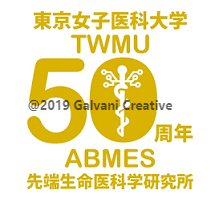中山正道 講師の論文です。
“Terminal cationization of poly(N-isopropylacrylamide) brush surfaces facilitates efficient thermoresponsive control of cell adhesion and detachment”
NAKAYAMA Masamichi†*, KANNO Tomonori, TAKAHASHI Hironobu, KIKUCHI Akihiko, YAMATO Masayuki, OKANO Teruo
Science and Technology of Advanced Materials, 22(1), 481-493(2021)
doi:10.1080/14686996.2021.1929464
Abstract
A variety of poly(N-isopropylacrylamide) (PIPAAm)-grafted surfaces have been reported for temperature-controlled cell adhesion/detachment. However, the surfaces reported to date need further improvement to achieve good outcomes for both cell adhesion and detachment, which are inherently contradictory behaviors. This study investigated the effects of terminal cationization and length of grafted PIPAAm chains on temperature-dependent cell behavior. PIPAAm brushes with three chain lengths were constructed on glass coverslips via surface-initiated reversible addition-fragmentation chain transfer (RAFT) polymerization. Terminal substitution of the grafted PIPAAm chains with either monocationic trimethylammonium or nonionic isopropyl moieties was performed through the reduction of terminal RAFT-related groups and subsequent thiol-ene reaction with the corresponding acrylamide derivatives. Although the thermoresponsive properties of the PIPAAm brush surfaces were scarcely affected by the terminal functional moiety, the zeta potentials of the cationized PIPAAm surfaces were higher than those of the nonionized ones, both below and above the phase transition temperature of PIPAAm (30°C). When bovine endothelial cells were cultured on each surface at 37°C, the number of adherent cells decreased with longer PIPAAm. Notably, cell adhesion on the cationized PIPAAm surfaces was higher than that on the nonionized surfaces. This terminal effect on cell adhesion gradually weakened with increasing PIPAAm length. In particular, long-chain PIPAAm brushes virtually showed cell repellency even at 37°C, regardless of the termini. Interestingly, moderately long-chain PIPAAm brushes promoted cell detachment at 20°C, with negligible terminal electrostatic interruption. Consequently, both cell adhesion and detachment were successfully improved by choosing an appropriate PIPAAm length with terminal cationization.





